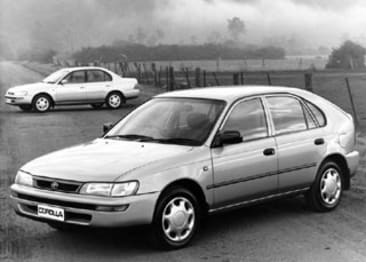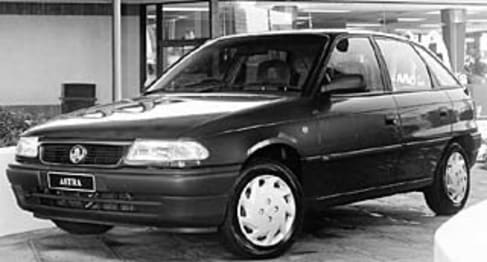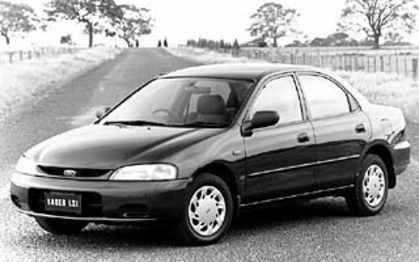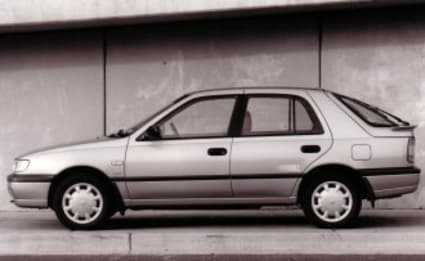
Used Toyota Corolla review: 1994-1999
- Toyota Corolla
- Toyota Corolla 1998
- Toyota Corolla 1999
- Toyota Corolla 1994
- Toyota Corolla 1995
- Toyota Corolla 1996
- Toyota Corolla 1997
- Toyota Corolla Reviews
- Toyota Reviews
- Toyota Hatchback Range
- Toyota Sedan Range
- Hatchback
- Sedan
- Toyota
- Used Car Reviews

What we like
- Reliable
- Solid and reassuring on the road
- No recalls affect this model
What we don't
- Low on power
- Almost non-existent safety
- Air-conditioning was an option on some
What we like
- Reliable
- Solid and reassuring on the road
- No recalls affect this model
What we don't
- Low on power
- Almost non-existent safety
- Air-conditioning was an option on some
Local car production was in full swing as the 1990s began. So strong was it that Toyota expanded its local manufacturing capacity with a new plant at Altona, in Melbourne's south-west.
The new AE101/AE102 Corolla became the first Toyota model produced at the Altona facility after it opened in 1994.
It was already one of the most popular cars selling in Australia, a runaway leader in the small car class, and the new model continued that run of success.
The Australian market was yet to undergo the massive transformation that took place in the following decade.
Small cars were then still regarded as a second family car, or one for the young driver, or the impoverished. They were much more basic than today’s small cars.
Models
The new Australian-built Corolla, with a range of four-door sedans (AE101) and five-door hatchbacks (AE102), the latter distinguished by the addition of the SECA badge, was a conventional front-wheel drive small car.
In addition to the choice of body styles there was also a range of variants to suit most budgets.

First in line was the CSi, which was powered by a 1.6-litre engine. From there the range climbed through the CS-X, with either a 1.6-litre or 1.8-litre engine, to the 1.8-litre Conquest, the sporty 1.8-litre RV, and finally to the 1.8-litre Ultima.
The CSi, CS-X and Conquest were available in sedan and hatch versions, but the RV was only available in hatch form, and the Ultima was only offered as a sedan.
You didn’t get a lot when you bought the entry-level CSi model. There was a tilt adjustable steering column, central locking (but it wasn’t remote), intermittent wipers, and radio-cassette sound.
The windows had to be cranked by hand, the mirrors had to be adjusted manually, there were no cup holders, and air-conditioning was an extra cost option.
It was a similar story with the Conquest, but you did get an anti-glare rear view mirror and a tachometer.
Step up to the better equipped CS-X and you got air-conditioning, but it wasn’t climate control, you also got velour trim, remote central locking, intermittent wipers, cup holders in the front, power windows front and back, power mirrors, and premium four-speaker sound.
If you went all the way and bought the Ultima you got a CD player, variable intermittent wipers, and the driver’s seat had electric lumbar adjustment.
Built well before the digital age the Corolla doesn’t have features such as MP3 or Bluetooth, so don’t bother trying to synch your iPhone or Android device.
Likewise it doesn’t have sat nav, a touch screen, parking sensors, or reversing cameras, and there was no sunroof option.
Cabin
Toyota promoted the new Corolla as being “really roomy”, and while it did boast a little more cabin space than its predecessor it was about average for the class.
The front and rear headroom was agreeable, but the rear seat legroom was tight if the front seats were adjusted right back.
It was also tight for width in the rear, and three adults would have found it a bit of a squeeze. It was rated as a five seater, and it might have been acceptable with kids in the rear, but not for three adults.
The boot space wasn’t overly generous, but the 60/40 split fold rear seat allowed extra space to be liberated when needed.
Engine
The 1.6-litre and 1.8-litre fuel-injected twin camshaft engines were well proven. Both were petrol; there was no diesel engine on offer.
With a new cylinder head, new pistons, new intake system and new management electronics the 1.6-litre engine was quieter and boasted better performance at low revs.
But even with the extra torque at low revs it was still marginal on overall power.
The more powerful 1.8-litre engine was a much better proposition. It was a smooth, willing performer that revved freely and drove nicely.
Driving
The Corolla wasn’t the liveliest small car in the market, but it was reasonable, particularly with the 1.8-litre engine.
The four-speed auto took the edge off the performance and made it feel slightly sluggish under acceleration. It was more of an issue with the smaller 1.6-litre engine than the more powerful 1.8-litre.
It wasn’t a sporty drive by any means, but it was assured and solid on the road.
The power steering was light and reassuring, and the blend of disc front and drum rear brakes was more than capable of bringing it safely to a halt.
Road noise was improved over the previous model thanks mostly to a more rigid body, but it was still higher than most owners would have liked.
Safety
While safety was an important concern for buyers in the early 1990s the cars they were buying didn’t have the vast array of safety gear we now take for granted.
No model in the Corolla range, not even the range-topping Ultima, boasted even the basic safety of ABS brakes.
But the Ultima did have an airbag. It was the only model to offer an airbag as standard equipment, but it only had one for the driver. Forget about airbags for the front seat passenger, or head or side airbags, they simply weren’t available.
You could have the safety of ABS brakes and a driver’s airbag if you were prepared to pay extra for the options.
This model Corolla came well before the advent of many of the safety systems that are commonplace today, including electronic stability control (ESC).
Likewise it was much too early for ISOFIX child restraint location points, which didn't become legal in Australia until 2014.
There was no ANCAP safety rating for this model.
Any common issues?
With the earliest examples of this generation of Corolla now 23 years old you can expect them to have on average 250,000 to 400,000 km, or even more, on the clock.
That’s a lot of kilometres in anyone’s language, and while the Corolla is a durable car you can expect it will be worn.
The best car to buy is the one with the lowest odometer reading that appears to have been well cared-for by past owners.
Engine wear will likely have robbed the engines of some of their performance, and the fuel economy could also reasonably be expected to have increased.
Check for black oil smoke from the exhaust while driving, that’s a sure sign of engine wear.
When driving, make sure the automatic transmission changes smoothly and engages gears without hesitation.
Automatic transmissions are often mistakenly regarded as not needing to be serviced, but they do their best when the oil is kept fresh.
Check for a service record to confirm a regular routine of servicing. Toyota’s recommendation was that the Corolla should be serviced every 10,000 km or six months; the cam-timing belt should be changed every 150,000 km or seven years.
Capped price servicing hadn’t been thought of when this Corolla was new to the market, but it’s not expensive to service and any competent local mechanic can do it.
The original warranty was for three years/100,000km, but that has long since expired.
It’s so old now that even used car dealers are not required to provide a warranty.
There are no recalls affecting this model Corolla, but if anything crops up, you’ll probably find it on our Toyota Corolla problems page.
Owners’ views
Doug Davidson: I can’t fault my 1997 Corolla. It has been a great run-around vehicle for local trips and even though it has done 270,000 km it continues to be very reliable.
Alan Brand: I’ve had four Corollas of this vintage, the latest a 1998, and I’ve never had any issues with any of them. They’ve all been reliable and have never once let me down.
Glen Irwin: My 1995 CSi isn’t the most exciting car, but it’s a beauty. It has always done everything it was meant to do, and continues to do so. The 1.6-litre engine pulls well enough, the manual gearbox is smooth and it’s more economical than I expected.
Ben Boswell: I love cars built before they went all tech and digital, cars like the Corolla. Its looks aren’t up to much, but it’s simple, reliable, economical, and doesn’t cost a fortune to service. It didn’t have a CD player, but I went out and bought one.
Pricing
| Year | Price From | Price To |
|---|---|---|
| 1999 | $2,090 | $4,070 |
| 1998 | $2,090 | $4,070 |
| 1997 | $1,980 | $4,070 |
| 1996 | $1,980 | $4,070 |
| 1995 | $1,980 | $4,070 |
| 1994 | $1,980 | $4,070 |
Pricing guides
Range and Specs
| Vehicle | Specs | Price* | |
|---|---|---|---|
| SE | 1.6L, ULP, 3 SP AUTO | $1,980 – 3,080 | 1994 Toyota Corolla 1994 SE Pricing and Specs |
| SE | 1.6L, ULP, 3 SP AUTO | $1,980 – 3,080 | 1994 Toyota Corolla 1994 SE Pricing and Specs |
| CSi Ltd Seca | 1.6L, ULP, 5 SP MAN | $2,090 – 3,300 | 1994 Toyota Corolla 1994 CSi Ltd Seca Pricing and Specs |
| CS-X Seca | 1.6L, ULP, 4 SP AUTO | $2,310 – 3,630 | 1994 Toyota Corolla 1994 CS-X Seca Pricing and Specs |
Other cars to consider
$2,310
Lowest price, based on third party pricing data











